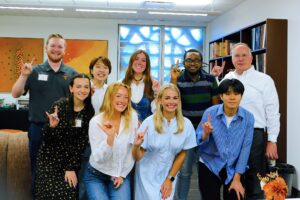This is the first story in a series of Further Findings posts in which researchers talk about the subjects they work with, from ants and rats to lasers and stars, from 18th century English literature to digital communications.

As a graduate student in biology, Janice Fischer had rotated through four laboratories and nothing had grabbed her imagination.
In the fifth lab, she found the fruit fly.
“That was it,” she said. “I wanted to stay there and, luckily, they let me.”
For 22 years Fischer, a professor in the Section of Molecular Cell and Developmental Biology, has been working with the fruit fly, Drosophila melanogaster, as her model organism.
Scientists have used the fruit fly for more than 100 years. Its genome was one of the first sequenced and published.
Many of the early genetics discoveries were made with fruit flies as the experimental subjects. Hermann J. Muller won a Nobel Prize in 1946 for genetics research he conducted on fruit flies at Texas.

Fischer uses the fruit fly to examine the cell-signaling processes that occur in the formation of the eye.
“We’re using development of the eye of the fly to study the molecular mechanisms of cell communication that are general to all cells,” she said. “So these mechanisms exist in humans almost identically.”
What happens with a fruit fly gene often happens with a human gene.
“Most genes that are associated with single gene diseases in humans, about 70 percent of them have a fly counterpart,” she said. “And for the most part they work similarly.”
Fischer and her lab have developed a model of Angelman Syndrome in the fruit fly. Angelman Syndrome characteristics include developmental delay, lack of speech, seizures, and walking and balance disorders.
There are several characteristics that recommend the fruit fly as a research subject.
They are cheap.
“The food and the upkeep is pretty minimal,” Fischer said, “and, at least for me, they don’t take an emotional toll on me either.”
They have a fast life cycle, breeding, living and dying in about two weeks.
“You can make a lot of mistakes,” she said. “If you’re trying to do a specific experiment that involves a certain combination of genes, if you do it wrong, it’s easy to say ‘Eh’ and fix it.”
The big payoff in working with fruit flies is the detailed genetic work that can be done.
“We can make flies with complex combinations of different kinds of mutant genes and transgenes to learn how these genes’ products interact with one another,” Fischer said. “You can manipulate the genome quite specifically.
“Sometimes it can be hard and the tools don’t always work exactly right. But if you work really hard at it, it’s not inconceivable to be able to turn any gene on or off at will in any cell at any time in a live animal.
“And that’s the appeal. It enables you to do precise experiments that are limited by only your own imagination and own willingness to take the time to make it work.”
Read more from Tim Green on his Further Findings research blog.



